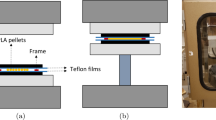Abstract
The use of molecular-level materials modelling techniques in the development of advanced performance polymers is discussed, with particular emphasis upon bridging the large difference in the scales of dimensions between atomic structure and fabricated parts. The advantages and disadvantages of bulk quantitative structure-property relations and atomistic modelling are assessed, and the method of group interaction modelling is suggested as a means of bridging the dimensional scales.
After a brief introduction to the concept of group interaction modelling, examples of modelling the engineering properties of polymers are presented which are difficult to model quantitatively by any other means. The important phase transitions from the crystal and glassy states of matter to those of rubber- and liquidlike states are shown quantitatively to be due to the same isoenergetic condition. The viscoelastic properties of a polymer are critical for many applications and expressions are derived for the loss and storage components of the complex modulus, with reference to failure initiation conditions. The effect of crosslinking in thermosets upon the glass transition temperature and viscoelastic properties is outlined. Finally, the scaling of time from atomic vibrations to the years involved in creep and ageing effects are discussed.
Similar content being viewed by others
References
Ashby, M.F.: Maker. Sci. Tech., 8:102, 1992.
Bicerano, J. (ed.): Computational Modelling of Polymers, New York: Marcel Dekker, 1992.
van Krevelen, D.W.: Properties of Polymers, Third Edition, Amsterdam: Elsevier, 1993.
Bicerano, J.: Prediction of Polymer Properties, New York: Marcel Dekker, 1993.
Chadi, J.D.: Condensed Matter Physics: Computer Simulations, Encyclopedia Britannica, Inc. Yearbook of Science and the Future (1994).
Theodorou, D.N. and Suter, U.W.: Macromolecules, 18:1467, 1985, and Macromolecules, 19:139, 1986.
Brown D. and Clarke, J.H.R.: Macromolecules, 24:2075, 1991.
Honnell, K.G., Hall, C.K., and Dickman, R.: J. Chem. Phys., 87:664, 1987, and J. Chem. Phys., 94:4659, 1991.
See for example Binder, K. Chapter 5 of reference #2.
Doi, M. and Edwards, S.F.: The Theory of Polymer Dynamics, Oxford: Clarendon Press, 1986.
Porter, D.: Group Interaction Modelling of Polymer Properties, New York: Marcel Dekker, 1995.
Porter, D.: Polymer Eng. Sci., 33:437, 1993.
Wunderlich, B., Cheng, S.Z.D., and K. Loufakis: Thermodynamic Properties in Encyclopedia of Polymer Science and Engineering, Vol. 16, New York: Wiley-Interscience, 1989.
Yee, A.F. and Smith, S.A.: Macromolecules, 14:54, 1981.
Turner, S.: Creep in Glassy Polymers in Physics of Glassy Polymers, Chapter 4, R.N. Haward (ed.), New York: Wiley, 1973.
Lee, W.A. and Knight, G.W.: Br. Polymer J., 2:75, 1970.
Author information
Authors and Affiliations
About this article
Cite this article
Porter, D. Materials modelling: A bridge from atoms to bulk properties. Adv Perform Mater 3, 309–324 (1996). https://doi.org/10.1007/BF00136794
Issue Date:
DOI: https://doi.org/10.1007/BF00136794




